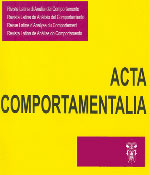Efeitos da ordem de ensino e da transferência de funções sobre relações ordinais em surdos
DOI:
https://doi.org/10.32870/ac.v19i1.28013Palavras-chave:
Controle de estímulos, relações ordinais, sobreposição de estímulos, ordem de ensino, crianças surdasResumo
O presente estudo verificou os efeitos da ordem de ensino e da transferência de funções sobre relações ordinais em crianças surdas. Doze crianças surdas foram distribuídas em dois grupos experimentais. No Grupo 1 a tarefa era ordenar os estímulos com base na numerosidade, e em seguida ordenar outros estímulos sem ter por base a numerosidade. No Grupo 2 os participantes eram expostos à ordem inversa. No procedimento de ensino informatizado, a tela do computador era dividida em “área de escolha”, onde os estímulos eram apresentados aos pares, e “área de construção”, onde os estímulos eram dispostos lado a lado após a seleção. Respostas corretas produziam uma animação na tela, após completar a seqüência. Caso contrário, a tela escurecia por 2 s. Após revisão da linha de base, eram apresentados testes de transitividade e conectividade. Todos os participantes atingiram o critério de acerto e foram capazes de formar novas seqüências, com alguma variabilidade inter e intra-sujeitos. Nos testes de conectividade, os participantes do Grupo 1 apresentaram um responder mais consistente com a linha de base. Houve transferência de funções ordinais para os novos estímulos, demonstrando-se a eficácia do procedimento de sobreposição no estabelecimento de classes de estímulos ordinais equivalentes.Downloads
Não há dados estatísticos.
Downloads
Como Citar
Assis, G., Silva Magalhães, P. G., Souza Monteiro, P. D., & dos Santos Carmo, J. (2011). Efeitos da ordem de ensino e da transferência de funções sobre relações ordinais em surdos. Acta Comportamentalia, 19(1). https://doi.org/10.32870/ac.v19i1.28013
Edição
Seção
Artículos
Licença

<a rel="license" href="http://creativecommons.org/licenses/by-nc-sa/4.0/"><img alt="Licencia de Creative Commons" style="border-width:0" src="https://i.creativecommons.org/l/by-nc-sa/4.0/88x31.png" /></a><br />Este obra está bajo una <a rel="license" href="http://creativecommons.org/licenses/by-nc-sa/4.0/">licencia de Creative Commons Reconocimiento-NoComercial-CompartirIgual 4.0 Internacional</a>.






